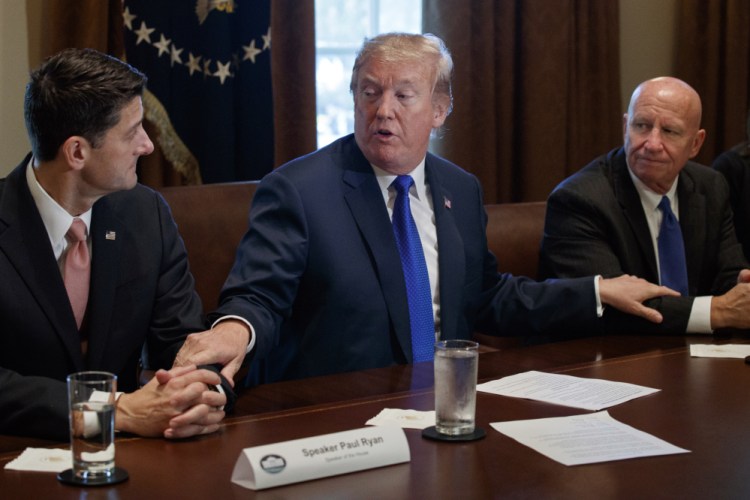WASHINGTON – House Republicans have stressed that the tax plan they unveiled Thursday is tailored to benefit America’s middle class. Just how much it would remains uncertain based on the details that have been provided so far.
The plan promises tax savings next year of $1,182 for a typical household of four with gross income of $59,000, leaving their tax bill at $400.
“We are focused on increasing paychecks in a major way,” said Rep. Kevin Brady, the Republican chairman of the House Ways and Means Committee.
But the proposal’s conflicting provisions and phase-outs of certain benefits suggest that taxes could rise for some middle class earners over time. And for many, the income gains being touted by President Trump are unlikely to materialize.
Some of these complications arise because under the budget instructions, the planned tax cuts can’t increase the national debt by more than $1.5 trillion over the next decade. Anything above $1.5 trillion would force Republicans to amend their plan to generate more revenue – a change that would likely prove difficult.
What seems clearer is that the tax plan’s primary beneficiaries would be wealthier Americans because they would enjoy lower tax rates despite the elimination of some tax breaks.
“With the details they’ve presented to us so far, it looks like the tax cut benefits the wealthy and major corporations,” said Martin Sullivan, chief economist at Tax Analysts and a former staff economist at the Treasury Department. “In fact, if you have a large family, given the facts that we have now, that you would pay more in taxes.”
Here’s why:
A married couple making less than $90,000 would be taxed at a 12 percent rate, instead of the current 15 percent. The size of their standard deduction would nearly double to $24,000.
But that same couple would lose personal exemptions – deductions that largely benefit families with multiple children. The child tax credit would rise to $1,600 from $1,000 – short of the $2,000 that Sullivan said would be needed to make many families whole.
The tax plan would also repeal the deduction of substantial medical costs. And it would cap the deduction of state and local taxes. It also would use a less generous measure of inflation, so that more middle class taxpayers would creep into a higher bracket over several years.
All told, the plan would increase income taxes on Americans overall by roughly $600 billion over 10 years. But much of that increase – largely from the loss of deductions – could fall on people who consider themselves part of the middle class or who live in areas of the country with higher housing costs.

The overarching promise made to the middle class by Trump and congressional Republicans is that lower taxes would fuel faster economic growth, which, in turn, would cause incomes to rise. Kevin Hassett, chair of Trump’s White House Council of Economic Advisers, estimates that lowering the corporate tax rate to 20 percent from 35 percent would lead to an average income gain of $4,000 a year.
But most mainstream economists have disputed that claim. Kent Smetters, faculty director of the Penn Wharton Budget Model, estimates that the income growth after a decade would range between $500 to $1,500.
Some tax experts say the tax overhaul might also hurt those who aspire to be middle class. The bottom half of taxpayers now pay no net income tax, according to Treasury Department figures. Many receive refunds via the Earned Income Tax Credit. The plan unveiled Thursday would require eligible taxpayers to provide their Social Security Number to receive this benefit, thereby creating a possible delay in receiving a refund as the IRS enforces this provision.
David Kamin, a former Obama White House official who now teaches law at New York University, said the plan seems to have “no significant help of any kind for about the bottom 35 percent of income earners.”
He added that the proposal could also “run up deficits significantly that would eventually have to be paid for and could threaten programs that do help low and middle income Americans whether that be health care coverage, Social Security, or investments like in infrastructure.”
Send questions/comments to the editors.



Success. Please wait for the page to reload. If the page does not reload within 5 seconds, please refresh the page.
Enter your email and password to access comments.
Hi, to comment on stories you must . This profile is in addition to your subscription and website login.
Already have a commenting profile? .
Invalid username/password.
Please check your email to confirm and complete your registration.
Only subscribers are eligible to post comments. Please subscribe or login first for digital access. Here’s why.
Use the form below to reset your password. When you've submitted your account email, we will send an email with a reset code.